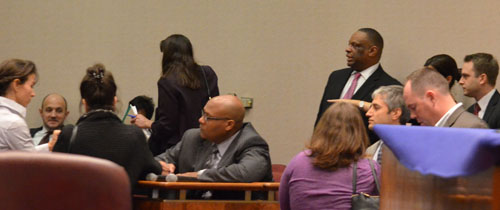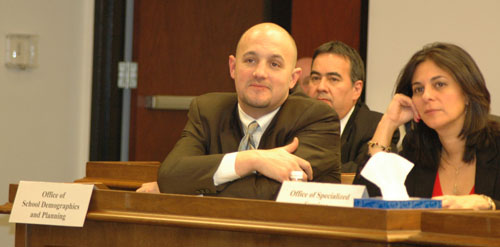Where was Jim Dispensa on November 20, 2012?... CPS sabotaging Facilities Task Force, hiding its own experts and then claiming it needs more time to do the job the law requires
There is a story, who cares if it's true, about a guy who murdered his Mom and Dad and then asked the trial court to show him mercy because he was an orphan. The same kind of thinking must have been coursing through the minds of the latest top officials at Chicago Public Schools when they re- re- reshuffled their leadership under the latest "Chief Executive Officer" (the fifth in four years), Barbara Byrd Bennett, and then told the world that they couldn't comply with the law this year while they worked to come up with a list of schools to be closed or "consolidated."
 Prior to the beginning of the City Council hearings on school closings and consolidations, Jim Dispensa, once the Chief Demographics person for CPS, sat among the CPS administrators in the Council chambers. By the time the hearings were called to order by Alderman Latasha Thomas, however, Dispensa was no longer among the CPS officials introduced. Instead, he had moved to the back of the chambers, ready to leave if any alderman noticed that there was at least one CPS official in the room who had vast knowledge and experience with closings. Above, Dispensa, second from left, sat among the CPS executives prior to the beginning of the hearing. Dispensa has more time at CPS than the four officials who can been seen in the above photograph (Ginger Ostro, Phillip Hampton, and Todd Babbitz) combined. Substance photo by George N. Schmidt.There was a tiny bit of truth to that particular lie. Between October 2011, when CPS held hearings and did comply with the law, and October - November 2012, when CPS refused to hold hearings in a run-up to defying the law, CPS had lost some of the officials who had done the work the previous year. Jamiko Rose, the community organizer who had been named the school system's first "Chief Officer for Family and Community Engagement" (FACE) during the summer of 2011 was gone by the autumn of 2012. So, apparently, was Oliver Sicat, who had been named the school system's "Chief Officer for Portfolio Management" around the same time as Jamiko Rose. Rose was among the disappeared. Sicat, if he were still at CPS on November 20, 2012, was no longer doing public Power Point, as he had the previous year.
Prior to the beginning of the City Council hearings on school closings and consolidations, Jim Dispensa, once the Chief Demographics person for CPS, sat among the CPS administrators in the Council chambers. By the time the hearings were called to order by Alderman Latasha Thomas, however, Dispensa was no longer among the CPS officials introduced. Instead, he had moved to the back of the chambers, ready to leave if any alderman noticed that there was at least one CPS official in the room who had vast knowledge and experience with closings. Above, Dispensa, second from left, sat among the CPS executives prior to the beginning of the hearing. Dispensa has more time at CPS than the four officials who can been seen in the above photograph (Ginger Ostro, Phillip Hampton, and Todd Babbitz) combined. Substance photo by George N. Schmidt.There was a tiny bit of truth to that particular lie. Between October 2011, when CPS held hearings and did comply with the law, and October - November 2012, when CPS refused to hold hearings in a run-up to defying the law, CPS had lost some of the officials who had done the work the previous year. Jamiko Rose, the community organizer who had been named the school system's first "Chief Officer for Family and Community Engagement" (FACE) during the summer of 2011 was gone by the autumn of 2012. So, apparently, was Oliver Sicat, who had been named the school system's "Chief Officer for Portfolio Management" around the same time as Jamiko Rose. Rose was among the disappeared. Sicat, if he were still at CPS on November 20, 2012, was no longer doing public Power Point, as he had the previous year.
And so the Chicago Board of Education, on behalf of the nation's third largest school system, brought forth a new team of rookie administrators to testify before City Council on November 20, and for the most part, none of them knew anything about the city's public schools. Who could be surprised. The main witness for CPS, a guy named Todd Babbitz, had only been hired as the school system's "Chief Transformation Officer" the previous July, at a salary of $195,000. And Babbitz, as he admitted to the aldermen whose constituents were facing, again, disruption because of CPS policies, didn't know much beyond the talking points he repeated, over and again, in answer to the specific questions posed by the aldermen.
For the past ten years, through five CEOs, CPS has had a department that was responsible for most of its demographic planning and work. The department, under the leadership of James Dispensa, carried out the regular work of drawing up the maps that told families where their children could go to school when new schools opened or old schools were changed. The department knew, intimately, every block in Chicago and had computer maps for every school's attendance boundaries.
 On February 14, 2008, James Dispensa sat behind a sign identifying his position as "Office of School Demographics and Planning" at the school closing hearing regarding De La Cruz Middle School, which was closed the following year after tearful protest from the entire community. Substance photo by George N. Schmidt.But when CPS officials, minus Barbara Byrd Bennett, went to the Chicago City Council to testify about their refusal to comply with the facilities law, they did not let the aldermen know that sitting just beyond them was the person who knew everything the aldermen might want to ask about. Prior to the beginning of the City Council hearings on school closings and consolidations, Jim Dispensa, once the Chief Demographics person for CPS, sat among the CPS administrators in the Council chambers. By the time the hearings were called to order by Alderman Latasha Thomas, however,
On February 14, 2008, James Dispensa sat behind a sign identifying his position as "Office of School Demographics and Planning" at the school closing hearing regarding De La Cruz Middle School, which was closed the following year after tearful protest from the entire community. Substance photo by George N. Schmidt.But when CPS officials, minus Barbara Byrd Bennett, went to the Chicago City Council to testify about their refusal to comply with the facilities law, they did not let the aldermen know that sitting just beyond them was the person who knew everything the aldermen might want to ask about. Prior to the beginning of the City Council hearings on school closings and consolidations, Jim Dispensa, once the Chief Demographics person for CPS, sat among the CPS administrators in the Council chambers. By the time the hearings were called to order by Alderman Latasha Thomas, however,
Dispensa was no longer among the CPS officials introduced. Instead, he had moved to the back of the chambers, ready to leave if any alderman noticed that there was at least one CPS official in the room who had vast knowledge and experience with closings. Dispensa sat among the CPS executives prior to the beginning of the hearing, and then moved to the back, seated nearest the door. Dispensa has more time at CPS than the four officials who can been seen in the above photograph (Ginger Ostro, Phillip Hampton, and Todd Babbitz) combined, but he was, at least on November 20, the man who wasn't there.
Two years ago, at the time Rahm Emanuel announced that he was returning to Chicago to run for mayor following the announcement by Mayor Richard M. Daley that he would not seek another term, Dispensa was working as "Director of School Demographics and Planning" at a salary of $115,000 per year, according to the CPS Position File. During the previous years, he had testified at more school closings (etc.) hearings than any other CPS official. In cases where schools were being closed for academic reasons, Dispensa's testimony was merely to tell the hearing officer that the change would not adversely affect the school's racial ethic composition. He did that more than 30 times according to a search of records obtained by Substance from CPS reports.
When it came time to prove that CPS had a demographic reason for closing a school, however, Dispensa's testimony was necessary to prove that the school was "underutilized." He did this usuing Power Point and other data representations, on school after school. Often, the CPS recommendation was out of context. Since the hearings were basically to establish whether CPS had followed its own rules, there was no cross examination of Dispensa or the other officials who testified against the schools.
During the years beginning in 2002 when the school closings began in earnest, Dispensa was the only regular witness for CPS. The person who testified about a school's academic "failure" changed several times. The lawyer who testified as to the legal rules (duly passed by the Board each year) changed. The Chief Executive Officer of CPS changed, as critics have noted regularly, changed between 2002 and the present. They have been: Barbara Byrd Bennett (current), Jean-Claude Brizard (2011 - 2012), Terry Mazany (2010 - 2011), Ron Huberman (2009 - 2011), Arne Duncan (2001 - 2009).
But throughout the entire decade that was launched when Arne Duncan announced he was going to close Williams, Dodge and Terrell elementary schools in April 2002, CPS had one person who was always there: James Dispensa.
CPS does not have the records of the more than 100 closings it did during the past decade on line, The following information comes from the official records of CPS that were gathered by Substance and are now also in the research library of the Chicago Teachers Union. As union officials have pointed out recently, in opposition to the proposed closings and consolidations for this school year, CPS has changed the criteria for closing every year since the process was begun in 2002.
On February 7, 2006, for example, James Dispensa testified on behalf of CPS on the proposed closing of Morse Elementary School (620 N Sawyer Ave., on Chicago's West Side. At a hearing that began at 7:00 p.m. at CPS headquarters that night, Dispensa testified that the closing of Morse, which was all-black, would not change the racial demographics of the schools in the area. Morse students were slated to be sent to Lafayette, Morton, and Ryerson elementary schools, with the Board of Education prepared to changed the attendance area maps for each of those schools to reflect the elimination of Morse. The man who made the maps was James Dispensa.
"I'm the manager of the School Demographics and Planning Department for the Chicago Public Schools," Dispensa testified. "Some of the functions of the department include the undertaking of demographic studies, enrollment projections, and space utilization analysis. As manager, my duties also include the preparation of the racial impact analysis reports required by the Board's policy on the closing of schools and by the Board's policy on the adjustment of attendance area boundaries."

